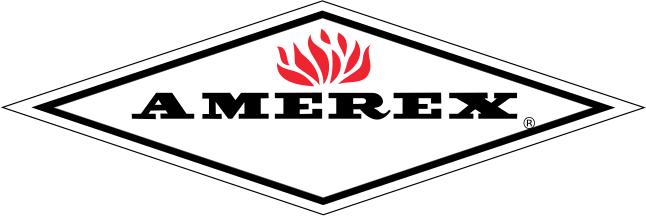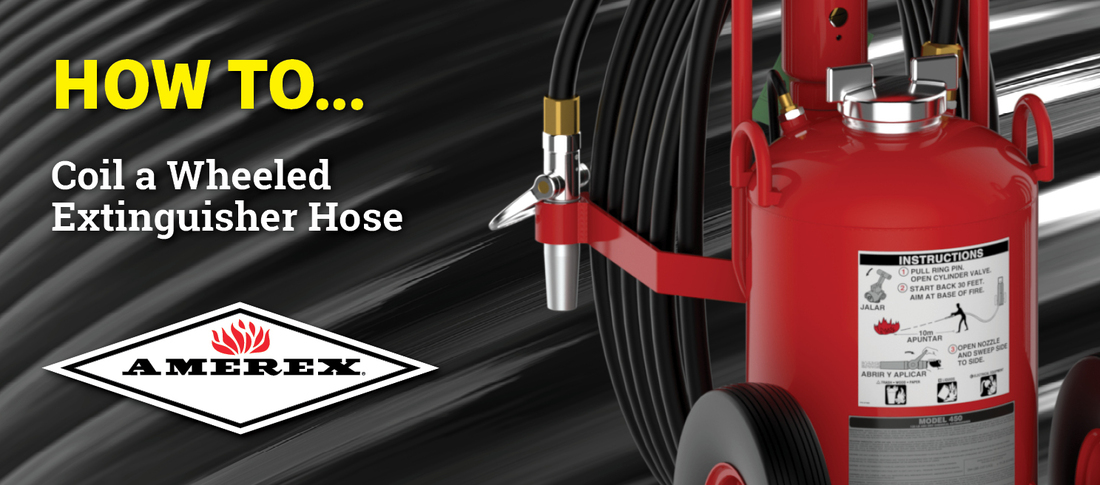It is Important that You Know how to Wind a Wheeled Fire Extinguisher Hose
Anyone who has wrangled with a tangled garden hose knows that an unproperly stored hose can create kinks that make it difficult for the water the flow. The same is true if you want to know how to wind a wheeled fire extinguisher hose. If the hose is not properly wound on your wheeled fire extinguisher, it can make it difficult to unwind or block the flow of the agent. And when you are facing a large scale fire such as at an airport, industrial operation, refinery, or other location, you need to act fast to spray the extinguishing agent on the fire.
Amerex wheeled fire extinguishers leave the plant with perfectly coiled hoses under the supervision of Carol Buckner, who has spent 25 of her 32 years at Amerex overseeing this process. There may be several reasons that the wheeled fire extinguisher hose will become uncoiled over the lifetime of the product. For one, there is the need for an annual inspection, where it is important to disconnect the hose from the agent cylinder to check the hose and hose gaskets for damage or deterioration.
A Lesson with the Expert
Carol offers a step-by-step guide to show you how to wind a wheeled fire extinguisher. She shares her tips and secrets from the years she has spent perfecting and teaching this process. Follow the video to see exactly how she completes the process from start to finish.
When Carol first learned how to wind the hose on a wheeled fire extinguisher, it took her about a week of non-stop practice to perfect this process. She tells the members of her team to expect the same. Carol says the first thing that you want to do is lean the unit back and then make sure that the hose is laid out straight in the direction where you want it to go.
“The biggest mistake I see people make,” says Carol. “Is getting the hose to roll in the right direction and not reversing the loop.” She says that once you begin the roll properly, you’ll feel it and the rest of the process will continue smoothly. Many times people put that initial roll up incorrectly because they get in a hurry and don't take the time to think it through.
She also suggests practicing on a 50 lb. wheeled fire extinguisher to start until you get the hang of the process. These smaller extinguishers are easier to work with and will allow you to get the hang of it before moving on to the bigger extinguisher.
Depending on the size of the wheeled fire extinguisher, Carol can usually wind the hose in about two to three minutes. Someone with less experience can expect to spend about 10 to 15 minutes to complete the process.
The ultimate secret to success with the hose winding process? It comes down to time and lots and lots of practice.
How to Maintain the Hose On Your Wheeled Fire Extinguisher
It is important that an annual inspection is conducting on each wheeled fire extinguisher. Remove hose and horn and visually inspect inside valve body. Inspect the hose, and replace if the hose is cut or cracked. Inspect the horn assembly for damage, and replace if it is brittle, cracked, or deformed. Blow air through the hose and nozzle assemblies to ensure passage is clear of foreign material.
You will also need to inspect the valve assembly for corrosion or damage to hose thread connection. Replace valve assembly or component parts as necessary following the proper depressurization and recharge procedures. Once this inspection process is completed, you will need to know how to wind a wheeled fire extinguisher hose to make sure the wheeled fire extinguisher is ready to use.
Refer to the Amerex Wheeled Unit Fire Extinguisher Product Manual for complete maitenance instructions.
What are the Types of Wheeled Fire Extinguishers Available?
Amerex offers a variety of wheeled fire extinguisher types. This includes stored pressure, high performance z series, direct pressure, halotron I, SF 1230, CO2, and Class D. They range in sizes from 50 lb. to 250 lb. The type of wheeled fire extinguisher and agent that you need will depend on the type of hazard. A complete hazard analysis should be determined before purchasing the wheeled fire extinguisher.
In addition, we offer replacement hoses for each of these wheeled fire extinguishers. Refer to our parts book to determine which hose you need to use for each wheeled fire extinguisher.
Want to learn more about our Amerex wheeled extinguishers?
View our Wheeled Fire Extinguisher Catalog
View our Wheeled Fire Extinguisher Products on our Web Store
View our Wheeled Fire Extinguisher Product Manuals
Need to know how to properly use a Wheeled Fire Extinguisher? View a Video here.


